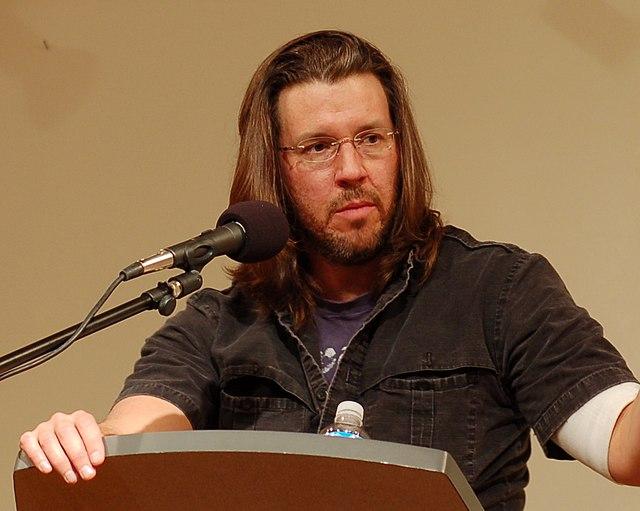
- TLDR: David Foster Wallace’s ‘This is Water’ speech contains unexpected wisdom for marketers: Embrace empathy, genuine connections, and authenticity in campaigns. It’s a valuable guide for marketers seeking a thoughtful approach.
- So What? Marketers benefit from “This is Water” because it emphasizes empathy and mindfulness. Understanding the human experience in marketing fosters genuine connections, authentic campaigns, and strong customer relationships, will ensure long-term brand loyalty and success.
“These two young fish are swimming along, and they happen to meet an older fish swimming the other way, who nods at them and says, “Morning, boys, how’s the water?” And the two young fish swim on for a bit, and then eventually one of them looks over at the other and goes, “What the hell is water?’”
The opening of David Foster Wallace’s “This is Water” is a short story, almost a joke. But as the speech unfolds, the ideas portrayed constantly return to this simple humor with increasing importance and emphasis.
By looking at this speech, we will dive into the power of humor and strong imagery to invite audiences to think outside their perceptions and see the world differently. This technique parallels Foster’s intended meaning and gives us marketers a technique to consider when trying to get our audiences to think about a bigger picture for themselves and others.
This speech and these ideas aren’t just applicable to young college grads heading out into the “real” world. They’re also important for marketers, too.
Using Humor and Allegory to Engage with Your Audience
Wallace’s commencement speech to Keyon College’s class of 2005 is, first and foremost, an attempt to settle back from the conventions of such speeches while using those conventions. Storytelling is a powerful tool, but these stories can feel rote or artificial in a world of rhetoric that seeks to provide moving insights.
Wallace knows this–but also knows that done right, the story-driven commencement works:
“This is a standard requirement of US commencement speeches, the deployment of didactic little parable-ish stories. The story thing turns out to be one of the better, less bullshitty conventions of the genre…”
Storytelling is inherently engaging, especially when it is done well. But “well” is relative, and Wallace takes a slightly different approach: identification through humor. By starting with allegory and then pointing out that A) it’s a cheesy part of this process and B) It does work, Wallace helps his audience identify with him. He’s not lecturing at them. He’s trying to communicate with them.
This can be a great technique for marketers to create rapport with their audience. Trying-and-true selling or thought leadership techniques can turn off readers if you can’t build a bridge between parties. A good way of doing that is by disarming their cynicism or resistance to communication.
Teaching Audiences Through Repeated Ideas
The humorous allegory Wallace uses to introduce the speech isn’t just for effect. It’s an idea that he keeps revisiting throughout the speech. By repeatedly returning to the ideas in that story without simply repeating them, Wallace essentially “teaches” them the message.
Wallace tells about the mundanity of everyday adult life after college. He talks about having to fight traffic to go to the store, the frustration of dealing with the other shoppers, the boredom of waiting in long lines, etc. This is the “water” of the initial parable–the normalcy of everyday life that we move through without even noticing we’re inundated by it:
“If you’re automatically sure that you know what reality is, and you are operating on your default setting, then you, like me, probably won’t consider possibilities that aren’t annoying and miserable. But if you really learn how to pay attention, then you will know there are other options.”
The content of this message is that we often run on our default… we don’t notice “the water” around us get outside of our minds to see the world as something else.
The rhetoric of this message, however, is a teaching moment:
“…learning how to think really means exercising some control over how and what you think. It means being conscious and aware enough to choose what you pay attention to and to choose how you construct meaning from experience. Because if you cannot exercise this kind of choice in adult life, you will be totally hosed.”
Marketers, especially B2B marketers, know a lot about teaching. It’s almost part of the job description. In this case, we can learn a few things:
- Even in B2B marketing, we can use anecdotes and narratives to set up ideas
- Returning to those ideas in different ways, ideally with real-world examples, makes those ideas substantive and solid for the audience
- We can use these techniques to guide audiences to open their minds to the potential of our message, whatever it may be.

Teach Audiences to See a Message. Do Not Manipulate.
The primary theme of Wallace’s speech is that learning how to think isn’t so much about the mechanics of thinking but about making choices as to what to think about or to focus on. He’s inviting the audience to think, not about a message, but their ability to think about their world.
Wallace says that education:
“…is not so much about filling you up with knowledge as it is about “teaching you how to think.” If you’re like me as a student, you’ve never liked hearing this…[But maybe it] isn’t really about the capacity to think, but rather about the choice of what to think about. If your total freedom of choice regarding what to think about seems too obvious to waste time discussing, I’d ask you to think about fish and water, and to bracket for just a few minutes your skepticism about the value of the totally obvious.”
This is a section where his message is just as important as his technique. If you’re a marketer looking to leverage sales language and tried-and-true messaging to evoke a response, you might step back and think about the value you bring to that audience. Because that audience isn’t just here to be sold–they are here with a need and the potential to create a relationship.
You’ve done the market research, so you know the demographic information about your target market. Did you choose to stop there and assume that the demographic information was all you needed to know? Do you see your target audience as a series of archetypes easily distinguished from one another?
Be Sincere and Honest in Marketing Communication
On the surface, marketing is straightforward: put your product in front of those who can use it.
The truth is that marketing is such a ubiquitous part of our culture that it’s easy to forget to see it as what it is: the work of building a relationship with a target market or audience. When you build symbiotic relationships and care about your audience as much as you hope they care about you, there is the opportunity to build something that will last and that you can work with in perpetuity.
But that takes patience, consideration of an audience’s needs, and the ability to build ideas that carry over whatever message or asset you create.
Or, as Wallace says, it’s about recognizing the water we’re all swimming in and being open to sharing that experience with your audience with education and compassion.
If you’re in a place where you want to integrate storytelling and sincerity into your content, then we’re here to help. Try our Media Shower Platform and see what it means to craft high-quality content that fits your brand.
